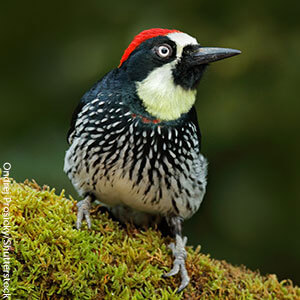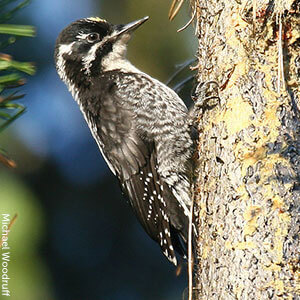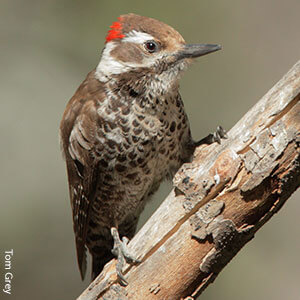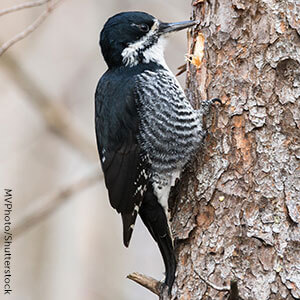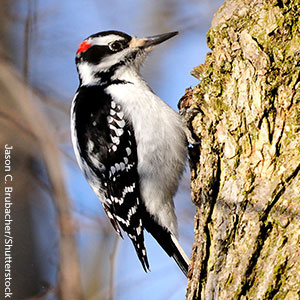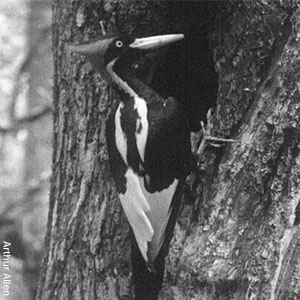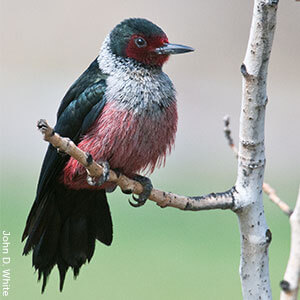Gila Woodpecker
U.S./Canada Population Estimate: 430,000
Population Trend: Decreasing
Habitat: Desert scrub
Threats: Habitat loss and invasive bird species (European Starling)
Note: Unlike most types of woodpeckers, the Gila Woodpecker does not nest in dead trees; instead, this desert-dwelling species prefers to raise its young in cavities within living Saguaro cacti. If current rates of decline persist, Gila Woodpecker populations may be halved in 50 years. |
Gilded Flicker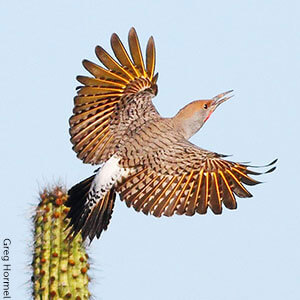 U.S./Canada Population Estimate: 240,000
Population Trend: Decreasing
Habitat: Desert scrub
Threats: Habitat loss, wildfires
Note: Gilded Woodpecker populations have declined by more than 50 percent over the last 50 years. It is a species of conservation concern and has been added to PIF's Yellow List. |
Golden-fronted Woodpecker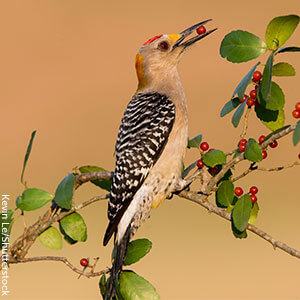
U.S./Canada Population Estimate: 820,000
Population Trend: Decreasing
Habitat: Dry forest
Threats: Potentially harmed by pesticides and habitat degradation
Note: Golden-fronted Woodpeckers range widely in Mexico and Central America. In the United States, they are found primarily in Texas and a small portion of Oklahoma. Golden-fronted Woodpecker populations have declined by more 45 percent over the last 50 years. |
U.S./Canada Population Estimate: 8,500,000
Population Trend: Increasing
Habitat: Eastern and western forests
Threats: Habitat fragmentation, invasive bird species (European Starling)
Note: Hairy Woodpeckers benefit from the work of other woodpeckers. They occasionally follow Pileated Woodpeckers, inspecting the larger birds' excavations for overlooked insects. Similarly, they drink sap from excavations made by sapsuckers. |
U.S./Canada Population Estimate: N/A
Population Trend: N/A
Habitat: Eastern forests
Threats: Historic habitat loss and hunting
Note: The last universally accepted sighting in the U.S. occurred in 1944. Although the Ivory-billed Woodpecker is still listed by the U.S. Fish and Wildlife Service as Endangered, it's widely agreed that the species is likely extinct. Sporadic reports of sightings continue, but undisputed evidence of the species' existence remains elusive. |
Ladder-backed Woodpecker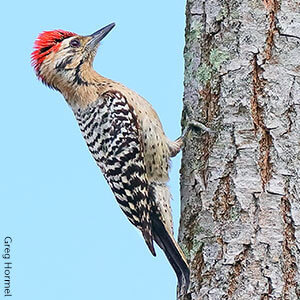 U.S./Canada Population Estimate: 2,100,000
Population Trend: Stable
Habitat: Desert scrub and open forests
Threats: Potentially affected by ranching and overgrazing
Note: Formerly known as the “Cactus Woodpecker,” the Ladder-backed Woodpecker is found throughout Mexico. Its range in the U.S. extends from Texas to California, where it thrives in dry habitats including mesquite thickets and pinyon-juniper forest. |
U.S./Canada Population Estimate: 69,000
Population Trend: Decreasing
Habitat: Dry, open western forests
Threats: Changes to forest composition due to fire suppression, grazing, logging, and climate change
Note: Unlike other types of woodpeckers, the Lewis's Woodpecker rarely bores into trees. Most often, it captures insects in the air. Lewis's Woodpecker populations have declined by more 70 percent over the last 50 years. It is a species of conservation concern and has been added to PIF's Yellow List. |
Northern Flicker U.S./Canada Population Estimate: 9,900,000
Population Trend: Decreasing
Habitat: Eastern and western forests
Threats: Not well understood. Possible causes include pesticide use, invasive bird species (European Starling), and loss of suitable nest-cavity trees.
Note: Northern Flickers subsist primarily on a diet of ants, which they dig out of the ground. They use their barbed tongues to quickly snatch up invertebrate prey. |
Nuttall's Woodpecker 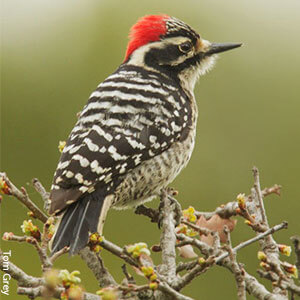
U.S./Canada Population Estimate: 650,000
Population Trend: Increasing
Habitat: Oak and riparian forests
Threats: Habitat loss
Note: Nuttall's Woodpeckers are found primarily in California's oak woodlands, but they do not eat acorns. Instead, they mainly subsist on an insect diet including beetles, termites, and ants. |
U.S./Canada Population Estimate: 2,600,000
Population Trend: Increasing
Habitat: Eastern and northwestern forests
Threats: Loss of suitable nest-cavity trees
Conservation Status: Except for the Ivory-bill, which is most likely extinct, the Pileated Woodpecker is the largest woodpecker in North America. Its massive excavations sometimes cause smaller trees to break in half. |
Red-bellied Woodpecker 
U.S./Canada Population Estimate: 15,000,000
Population Trend: Increasing
Habitat: Eastern forests
Threats: Potential dangers include pesticides, habitat degradation, invasive bird species (European Starling)
Note: Like all types of woodpeckers, Red-bellied Woodpeckers are cavity-nesters. Although they sometimes evict smaller Red-cockaded Woodpeckers from nest sites, Red-bellieds themselves are more often displaced by European Starlings. |
Red-breasted Sapsucker U.S./Canada Population Estimate: 2,300,000
Population Trend: Increasing
Habitat: Western forests
Threats: Loss of suitable nest-cavity trees
Note: Like other sapsuckers, the Red-breasted Sapsucker feeds on tree sap as well as insects. The holes they drill to harvest sap (known as sap wells) provide some hummingbird species with an additional food source. |
U.S./Canada Population Estimate: 15,000
Population Trend: Decreasing
Habitat: Longleaf Pine forest
Threats: Habitat loss and fragmentation
Note: The Red-cockaded is one of the few woodpeckers to excavate cavities in living, green wood. These birds live in family groups, primarily in mature Longleaf Pine stands with little understory. As these forests have disappeared, so have Red-cockaded Woodpeckers; their populations have declined by more than 80 percent over the last 50 years. The U.S. Fish and Wildlife Service listed these birds as Endangered in 1970. |
U.S./Canada Population Estimate: 1,600,000
Population Trend: Decreasing
Habitat: Eastern forests
Threats: Altered forest composition leading to decreased food supplies and nesting sites
Note: Red-headed Woodpeckers store nuts like Acorn Woodpeckers, eat fruit, and will catch insects on the wing like flycatchers. Their populations have declined by nearly 70 percent over the last 50 years. They are listed as Near Threatened on the IUCN Red List, and have been placed on the State of the Birds Watch List. |
Red-naped Sapsucker U.S./Canada Population Estimate: 2,000,000
Population Trend: Increasing
Habitat: Western forests
Threats: Habitat loss and degradation
Note: As is true with many other abandoned woodpecker holes, Red-naped Sapsucker cavities provide excellent homes for birds that can't excavate their own nest sites. In the case of the Red-naped, beneficiaries include nuthatches, chickadees, and Mountain Bluebirds. |
White-headed Woodpecker U.S./Canada Population Estimate: 200,000
Population Trend: Increasing
Habitat: Western pine forests
Threats: Habitat loss and fragmentation, fire suppression, snag removal
Note: Rather than hammer into wood for insects, White-headed Woodpeckers find prey by peeling away tree bark and investigating needle clusters. They are found in mountainous pine forests in parts of the West. White-headed Woodpeckers are listed as Critical in Idaho and Sensitive in Oregon where Ponderosa Pine logging has been extensive. |
U.S./Canada Population Estimate: 290,000
Population Trend: Increasing
Habitat: Western forests
Threats: Habitat loss
Note: The difference in coloration between male and female Williamson's Sapsuckers is so striking that they were originally thought to be different species. While males sport colorful plumage with highlights of red and yellow, females have a more subdued, barred appearance, resembling small flickers. |
Yellow-bellied Sapsucker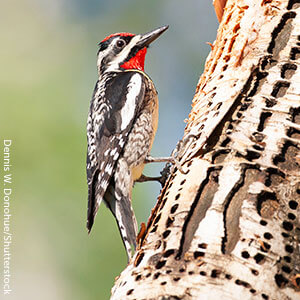 U.S./Canada Population Estimate: 12,000,000
Population Trend: Increasing
Habitat: Eastern forests
Threats: Localized effects of habitat loss
Note: The Yellow-bellied Sapsucker is the only migratory woodpecker in North America in which virtually the entire population moves each year. During the winter, nearly all of these birds leave their breeding grounds in the northern U.S. and Canada. While many winter in the southern U.S. and Mexico, some travel as far south as Panama. |





































